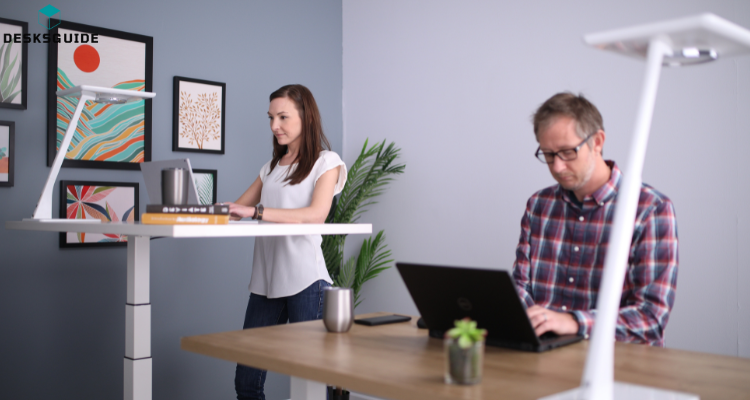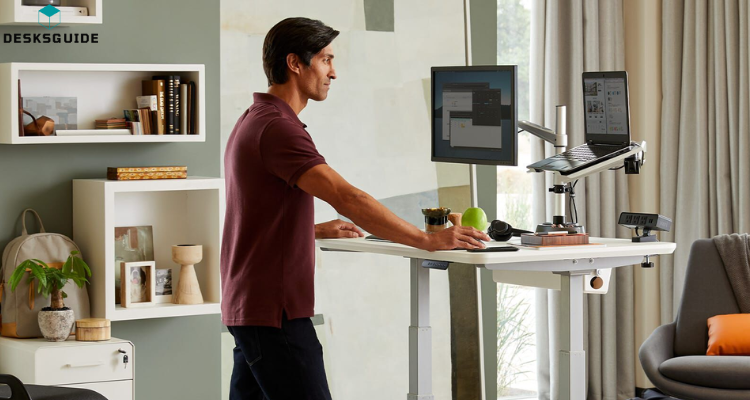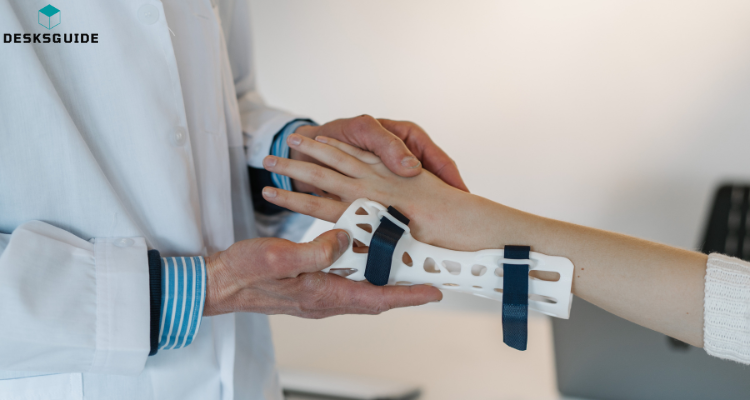Standing desks have seen a tremendous rise in popularity over the past few years. With social media influencers hopping on the bandwagon and using their platforms to warn of the dangers of prolonged sitting, height-adjustable desks have only moved further into the spotlight.
Table of Contents
The appeal is not lost to the masses—a desk that can have its height adjusted and allow you to work while sitting or standing along with enormous advantages of using a standing desk.
No more sore muscles and neck pain from long periods spent perched on a chair. You can choose when you need to put some weight on your feet without delaying work—an office worker’s dream come true.
But these aren’t the only traits that make sit-stand desks superior to your regular old office desk, the benefits of standing desks don’t just end at convenience but shifting your position every once in a while throughout the day can have its health benefits.
Standing Desks Vs. Regular Desks—What’s the Difference?

While the main difference between both is obvious, standing desks are further divided into two subcategories, each with its own specific trait that sets it apart from a conventional office desk.
A fixed standing desk remains in one position, a set height above the ground that cannot be changed. Only dissimilar from a regular desk in the fact that its height is significantly taller, meant for use while on your feet without the ability to alter it.
The other category of standing desks is sit-stand desks—these are the more popular options and provide the ability to adjust their heights. Using a control, you can either move the desk in a position suitable for sitting or standing.
Both allow you to work while standing, which is the primary difference between a standing desk and a regular desk.
Advantages of Using a Standing Desk
Standing desks eliminate many of the side effects that come with prolonged periods of sitting. They provide the best of both worlds—sit when you feel necessary or stand if you tire of working in one single position. Standing also diminishes several health risks including improved neck pain, more calories burned, and a positive impact on your mental health.
1. Improved Posture

If you sit in the same position for a significant length of time, it is inevitable you forget proper ergonomics and start to slouch. Not only can doing so cause back and neck pain but also lead to bad posture, which can be difficult to correct.
Height-adjustable desks can help avoid this—occasionally raising the desk to a height more suited for standing will help you ensure your back stays straight and you don’t hunch over. You can check out our detailed guide on how to calculate the best-suited height of standing desk for you.
A good method of guaranteeing better posture while standing is to breathe in and while holding this position, breathe out. Keep your head held high and make sure your chin is parallel to the ground. Raise the standing desk to a height so that the monitor is directly in front of you.
You don’t have to stand for hours on the end to start noticing a difference—each time you tire of sitting and start to feel like you might slump over, raise the sit-stand desk and stand for 20 to 30 minutes.
2. Improves Blood Circulation
Humans need to stand and put their muscles to work if we are to have a healthy lifestyle. Spending a significant chunk of your day not using most of your muscles can hinder blood flow. Prolonged sitting can cause blood to pool in your legs, and this might even lead to a clot.
It is not always possible for you to go on a short walk and put your leg muscles to use, especially for office workers. By getting a height-adjustable desk, users can incorporate standing in their day-to-day work life and ensure blood flow is evenly distributed throughout the body and doesn’t pool.
Spending more time sitting than standing can also cause an increased risk of cardiovascular events such as a stroke, heart attack, and extreme fatigue. Purchasing a sit-stand desk is an investment that can help keep you healthy. Long duration sitting can also cause, feet swelling and how to get rid of that, check out our detailed guide on that.
3. Increases Productivity and Focus
Sitting for long periods can cause you to feel sluggish and lazy, requiring an increasing amount of effort to stay focused on the task at hand. A small movement while working will be enough to keep you awake and boost productivity.
In an analysis of several studies, researchers published a report that indicated 66% of office workers felt more productive and 87% felt more energetic after only spending an hour working on a standing desk. More such studies have encouraged multiple organizations to make workplaces more flexible and swap much of the office furniture for better alternatives.
This theory is further strengthened by the results of another 7-week study conducted on participants who agreed to work on a standing desk—results revealed that working while standing caused less fatigue and reduced stress among the members.
4. Helps Burn Calories
If you’re struggling to keep yourself fit and safe from weight gain, a standing desk can be the answer. Standing for an hour can burn anywhere between 100 to 200 calories while sitting only burns 60 to 130 calories.
The difference between standing versus sitting here might not seem huge, but with time the small difference can add up to a considerable amount. Although you won’t see a significant loss in weight simply by standing, the calories standing desk users lose will be a few hundred less to burn in the gym.
This added boon is also acknowledged and confirmed in an article by a faculty member of the Harvard Medical School. However, you should keep in mind that the few extra calories you lose aren’t replacements for actual exercise, you are unlikely to see a difference in your weight if you forgo going to the gym.
5. Prevents Back Pain

Back pain can be a product of poor posture and poor ergonomics. A simple solution would be to reduce your sitting time and take a break to stand up. Desks that allow you to adjust heights are a convenient method of not putting aside work each time you need to stretch your legs.
Sitting in an office chair puts stress on your shoulders, back, arms, legs, and to your back muscles. The added amount of pressure on your body takes its toll and you start to feel the effects of sitting for a longer duration. Standing up every once in a while for a brief period can help avoid these pains.
A study published by the CDC further proves the connection between back pain and sitting for prolonged periods. The research suggests that 54% of the participants noticed an improvement in upper back and neck pain after using a standing desk for four weeks.
6. Improves Mood and Energy
If you feel tired and can’t wait for the workday to be over, shifting to a standing desk might help improve your mood and give you a final short burst of energy to get through the rest of the day.
A study conducted by researchers from Texas A&M University on workers in a call center revealed that the employees were almost 50% more productive when they stood up to get their work done.
Another research backs the findings of those of Texas University—this week-long study revealed that 87% of the participants using a standing desk reported feeling more energized and in better moods.
7. May Help Lower Blood Sugar Levels
Regardless of whether you suffer from diabetes or not, keeping blood sugar levels to a minimum is a necessity that any nutritionist won’t argue against. This is especially true immediately after you’ve had a meal.
A study conducted on a group of office workers revealed that standing for two hours after lunch reduced their blood sugar spike by 43% as compared to those who had been sitting.
Another group alternated between sitting and standing and sitting every 30 minutes and showed an 11.1% decrease in blood sugar spikes.
You can have half the risk of getting type 2 diabetes if you were to make a habit of standing after meals rather than sitting. A standing desk can help incorporate the required time you need to stand in your routine without disrupting your work.
8. Helps Prevent Joint Pain and Sore Muscles

Wrist strain is among the most common types of pain that accompany bad ergonomics. If you are using a laptop, you might notice your wrists start to drop on their own accord to rest on the keyboard, this is because of the awkward position they are in.
A standing desk allows your hands to stay in a comfortable position at a 90 to 100-degree angle, which is the ideal practice.
Sore muscles are also a product of bad sitting habits or occur because your desk is too high to too low. Sit-stand desks allow you to adjust this height and fix them in a position most comfortable for you, rendering it unlikely that you will ever again have to suffer from joint pain or sore muscles after working on your desk.
Do You Really Need a Standing Desk?
Now that the facts have been laid bare before you comes the question of whether you really need to invest in a standing desk. The answer depends entirely on you and the time you spend sitting at your desk.
If you dedicate a considerable part of the day to using your computer, a height-adjustable desk is a must. A small investment now could save you from suffering the side effects of poor ergonomics owing to the enormous benefits of a standing desk.
However, if using a computer is a minor part of your routine and you don’t work at your desk, a standing desk might not be necessary.
Top 03 Best Standing Desks
Cons of Standing Desks
While standing desks have a significant number of advantages over regular desks, they also have their own set of pain points that are worth mentioning.
The first and the worst disadvantage of sit-stand desks is their slightly high price. Many of the popular brands aren’t cheap and you might have to set aside a good amount to purchase one as they come with a lot of advantages mentioned above as compared to a regular desk.
Another important point worth remembering is that standing desks aren’t a replacement for exercise. Many purchase one thinking they won’t have to worry about weight gain again. Although standing desks may allow you to lose a few hundred extra calories, they aren’t your ticket out of ever having to work out again.
Video Recommendation
Frequently Asked Questions (FAQs):
Is it good to use a standing desk all day?
Using a standing desk all day can be beneficial in reducing sitting time and promoting movement. However, prolonged standing without breaks may lead to discomfort in the legs and back. It’s recommended to alternate between sitting and standing, take regular movement breaks, and perform stretching exercises to maintain comfort and health.
Is it healthy to stand for 8 hours?
Standing continuously for 8 hours without breaks can lead to discomfort, fatigue, and potential health issues like leg and back pain, swelling, and circulation problems. It’s crucial to alternate between sitting and standing, take regular breaks, and use ergonomic aids to alleviate the strain of prolonged standing for better comfort and health.
Does standing desk burn calories?
Using a standing desk can slightly increase calorie expenditure compared to sitting, as standing requires more muscle activity. However, the calorie burn difference between standing and sitting at a desk is minimal. Standing burns approximately 50 calories more per hour than sitting. While it’s not a significant amount, over time, it can contribute to a modest increase in overall calorie expenditure.
Final Verdict
Standing desks are everything you have been looking for in a desk. Work while standing or sitting or alternate between them with just a tap of a button.
Not only do standing desks have numerous health benefits, but they can also spice up any boring desk job. If you’re an office worker who rarely gets to stretch their legs, a sit-stand desk can put much-needed excitement into your job. You can also avoid succumbing to bad posture by having to sit on a chair for hours on the end.
Standing has proven to burn calories, so if you’re looking to lose weight, working while standing combined with a modest workout in the gym can do wonders as it provides the benefits of a standing position.
You can also focus more on work as standing can boost productivity and focus. With your feet under you, you can stay alert and energetic, dedicating your attention to the task at hand.
Read also: Gaming Desk vs Regular Desk (What are the 09 Significant Differences)